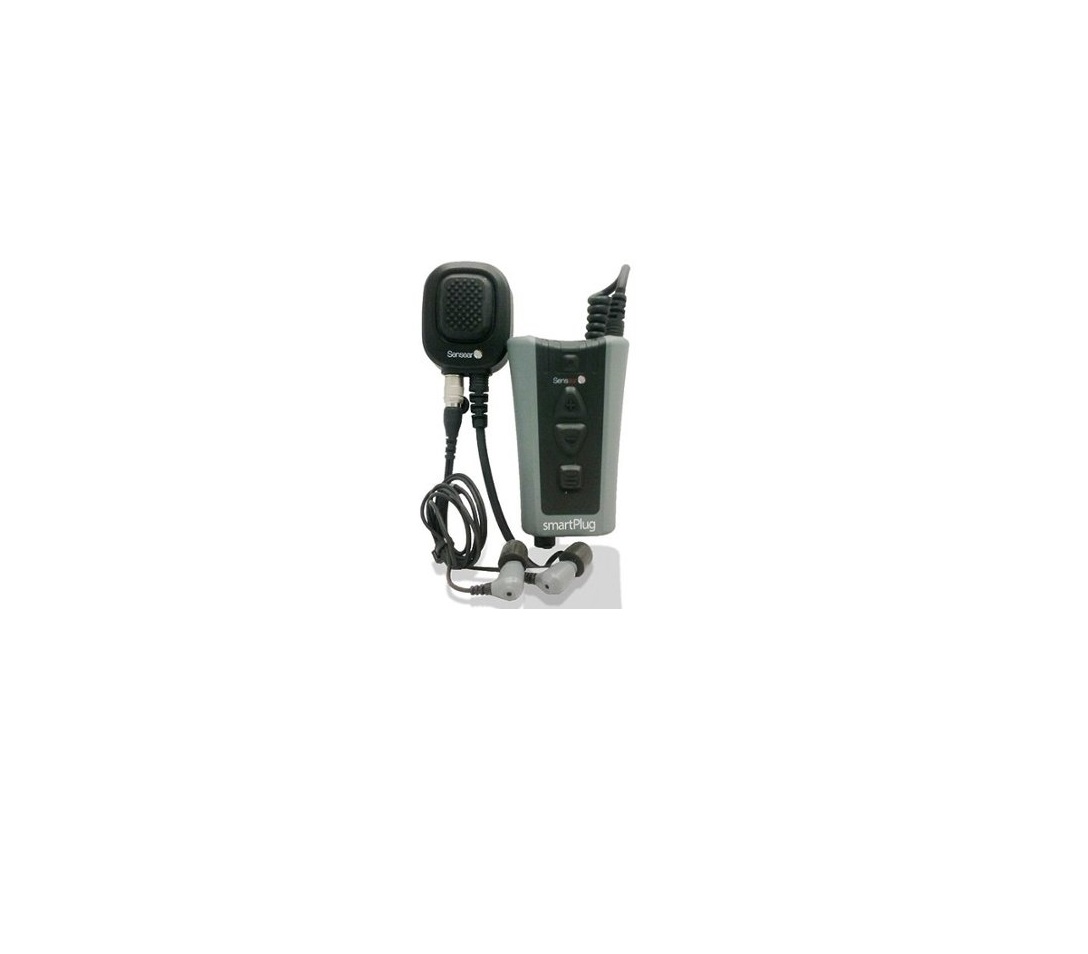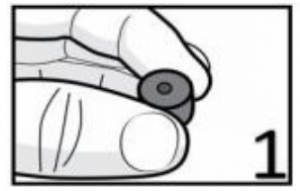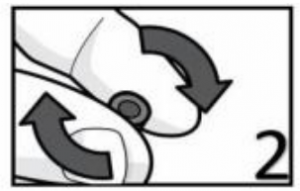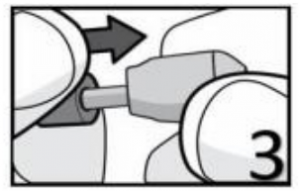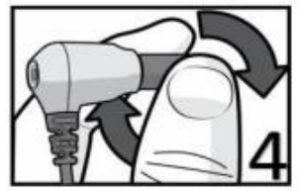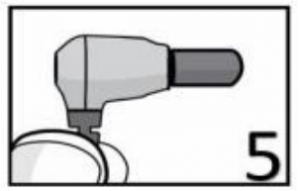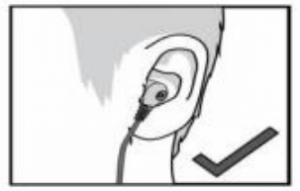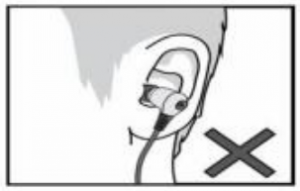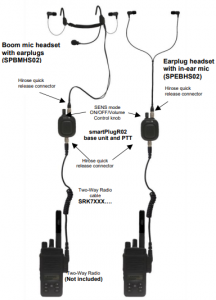Sensear SP1R Headset Information User Manual
INTRODUCTION
The SP1R is a state-of-the-art hearing protection (ie protects against harmful noise) communication system that allows you to retain situational awareness while remaining in full contact with your two-way radio communication device.
Situational awareness is provide by processing technology and environmental microphones mounted within the earbuds.
The SP1R headset draws power from the two-way radio. It must be connected by the appropriate SRCK7(XXX) radio cable to utilize both the situational awareness and two-way radio communications
SRCK7(XXX) part numbers vary depending on the radio connector and are sold separately. For language translated manuals and further information please visit www.sensear.com.
The SP1R is designed to be worn with the main housing attaching to the belt or pant seam, and the Inline PTT attaching to the shirt / upper garment.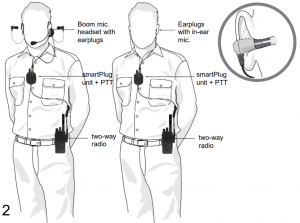
FITTING THE EARBUDS
The SP1R comes with a detachable earpiece assembly designed for ease of serviceability and hygiene for users who share the base unit. For further information and to order additional earpiece assemblies, please contact your supplier or visit www.sensear.com
- Place disposable foam tip between thumb and forefinger.

- Roll foam tip to a compressed, crease free cylinder.

- Push the foam tip all the way onto the ear bud spout.

- Roll the foam tip again between the thumb and forefinger.

- Ensure the foam tip remains a compressed crease-free cylinder.

- Using your opposite hand, pull your ear upward &outward.

- Insert the earbud and hold in place for 30 seconds while the foam tip expands. Proper fit is ensured by not having any of the foam tip visible while the earbud is in the ear.



OPERATING THE HEADSET
POWER ON:
- Connect the SRCK7XXX radio cable to the Hirose connector on the bottom of the main unit.
- Connect the SRCK7XXX cable to the two-way radio.
- Turn the two-way radio on.
- The headset will power up. An audible “Sensear, sounds good to me” will be heard through the headset.
POWER OFF:Option 1. Turn the two-way radio off from the two-way radio.Option 2. Disconnect the headset cable from the SRCK7XXX cable.(Option 2. Reverts audio back to the two-way radio automatically)
ENVIRONMENTAL MODES
MODE:Mode can be turned on and off by turning the volume knob to the on/off position with a click, which will toggle the unit into mode or quiet mode, while also controlling the volume level. This allows for easy muting of Sensear’s situational awareness feature when, and if, this is preferred by the user.
COMMUNICATING OVER TWO-WAY RADIO
- Press and hold the built-inPTT button located on the SP1R unit.
- Release the inline PTT button to cease transmission.

MAINTENANCE AND STORAGE
This product may be adversely affected by certain chemical substances. Further information should be sought from the manufacturer.
The headset should be stored at room temperature (between15°C/59°F and 25°C/77°F).
ACCESSORIES AND SPARE PARTS
The following accessories and spare parts may be ordered separately:
|
SRCK7xxx |
Various models, two-way radio interface cables for most popular two-way radios. |
|
SPEBHS02 |
SP1R earpieces with Hirose connector |
| SPBMHS02 |
SP1R Boom Mic headset with earplugs with Hirose connector |
|
FETSM010 |
Foam ear tip – small (10.5mm) – 10 pair |
|
FETMD010 |
Foam ear tip – medium (12mm) – 10 pair |
|
FETLG010 |
Foam ear tip – large (14mm) – 10 pair |
Further information may be obtained from your Sensear representative, via the Sensear web site, or by emailing or writing to the address onthis User Manual.
DECLARATION OF CONFORMITY
We, the undersigned.
Company Address :Sensear Pty Ltd 199 Great Eastern Highway, Belmont, WACountry :AustraliaTelephone No.+61 8 92777 7332Web : http://www.sensear.com/Email : [email protected]
Declare that:Model SP1R in accordance with the following directives:
- 2011/65/EU
- 89/686/EEC
Has been designed and manufactured to the following specifications:
- EN 352-2:2002 Hearing Protectors – Safety requirements and Testing – Ear Plugs
- EN 352-7:2002 Hearing Protectors – Safety Requirements and Testing – Level-dependent Ear Plugs
Sensear Standard Warranty Terms and Conditions
Sensear Pty Ltd(“SENSEAR”) warrants the SENSEAR manufactured HEARING PROTECTION products (“Product”) listed below to be free from defects in material and workmanship under normal use and service for a period of 12 months from the original date of purchase.
SENSEAR will at its absolute discretion repair or replace the Product where a defect in material or workmanship occurs, at no charge to the end user for parts or labour. SENSEAR reserves the right to replace the Product with the same or equivalent part or Product rather than repair it. Where a part or Product is replaced, the part or Product becomes the property of SENSEAR. SENSEAR reserves the right to use refurbished parts or Product for repair or replacement.
SENSEAR is not responsible for any damage caused to or by accessory or ancillary equipment connected or attached to the Product that is not provided by SENSEAR and is not expressly designed to operate in conjunction with the Product.
This warranty is not assignable or transferable to any other party, this warranty is extended to the original purchaser of the Product only.
This warranty is in addition to your statutory rights provided under the Trade Practices Act, or relevant legislation in your state or territory.
SENSEAR reserves the right to limit its liability to the repair, replacement or refund of the purchase price of a Product. Under no event shall SENSEAR be liable for damages in excess of the original purchase price of the Product, for any loss of use, loss of time, inconvenience, loss of profits or savings, loss of revenue, commercial loss or any other incidental, special or consequential loss to the full extent such may be disclaimed by the law.
This warranty does not cover:
- Defect or damage resulting from use of the Product in other than its normal or intended manner.
- Defects or damage occurring from misuse, abuse, accident, corrosion, fire, liquid intrusion or neglect, including during transportation.
- Defects or damage occurred from improper or unauthorized testing, operation, maintenance, service, repair, alteration, modification or adjustment.
- Freight costs to the place of repair.
- Product that has been subjected to unauthorized or illegal alteration of the firmware or software in the Product.
- Cosmetic damage to the Product that does not interfere with the intended operation of the Product.
- Normal wear and tear.
- Product where the serial number has been removed or altered.
- Any batteries rechargeable or otherwise either shipped with or internal to the Product.
- Any consumable items, for example replaceable ear-tips or ear-cup pads.
- Warranty claims made outside of the warranty period.
- Warranty claims made without appropriate proof of purchase bearing both the original purchase price and date.
- All other warranties, conditions, terms, representations and undertakings whether express or implied.
How to Get Warranty Service
To register your product visit:http://www.sensear.com/support/headset-registrationIf you require warranty service visit:http://www.sensear.com/support/returns-repairs-new
FORWARD
Product Safety and RF Exposure Compliance:This product is designed to be used in isolation or in conjunction with a two-way radio. Before using this product with a two-way radio, read the operating instructions for safe usage contained in the Product Safety and RF Exposure booklet enclosed with the two-way radio.
FCC COMPLIANCE STATEMENT
This equipment has been tested and found to comply with the limits for a Class B digital device, pursuant to part 15 of the FCC Rules. These limits are designed to provide reasonable protection against harmful interference in a residential installation. This equipment generates, uses and can radiate radio frequency energy and, if not installed and used in accordance with the instructions, may cause harmful interference to radio communications. However, there is no guarantee that interference will not occur in a particular installation. If this equipment does cause harmful interference to radio or television reception, which can be determined by turning the equipment off and on, the user is encouraged to try to correct the interference by one or more of the following measures:
- Reorient or relocate the receiving antenna
- Increase the separation between the equipment and receive.
- Connect the equipment in to an outlet on a circuit different from that to which the receiver is connected
- Consult the dealer or an experienced radio/TV technician for help
SPECIFICATIONS
| SPECIFICATION | SP1R | |
|
Weight |
107.2g |
3.8oz |
|
Operational Temperature |
-25°C to +60°C |
-13°F to +140°F |
|
Power |
See radio cable documentation |
|
|
Housing Material |
PC/ABS + TPE |
|
|
RoHS Compliant |
Yes |
NRR AND SLC80
The SP1R has been certified to International hearing protection standards including EN352-2, EN352-7, ANSI S3.19-1974, ANSI 12.6-2008 and AS/NZS 1270-2002. The following passive attenuation ratings were observed:
PASSIVE ATTENUATION (ANSI S3.19 -1974)
SP1R measured in accordance with ANSI S3.19 -1974.Foam tips (sml, med, lrg)
|
Frequency (Hz) |
125 | 250 | 500 | 1000 | 2000 | 3150 | 4000 | 6300 | 8000 |
NRR |
|
Mean attenuation (dB) |
38.2 | 35.6 | 40.3 | 39.6 | 40.7 | 42.9 | 40.9 | 44.5 |
45.8 |
31 dB |
|
Standard deviation (dB) |
4.2 | 2.8 | 3.9 | 4.2 | 3.8 | 3.5 | 2.9 | 4.4 |
3.9 |
PASSIVE ATTENUATION (ANSI S12.6 – 2008)
SP1R measured in accordance with ANSI S12.6 – 2008 (Method B)Foam tips (sml, med, lrg)
|
Frequency (Hz) |
125 | 250 | 500 | 1000 | 2000 | 4000 | 8000 |
NRS |
|
Mean attenuation (dB) |
32.0 | 29.2 | 32.3 | 32.5 | 37.0 | 40.8 |
42.6 |
29 to 39 dB |
|
Standard deviation (dB) |
6.1 | 6.5 | 6.8 | 6.7 | 5.1 | 5.8 |
4.5 |
|
|
APV 84% |
26.9 | 23.7 | 26.6 | 26.9 | 32.7 | 35.9 |
38.8 |
PASSIVE ATTENUATION (AS/NZS 1270:2002)
SP1R measured in accordance with AS/NZS 1270:2002.Foam tips (sml, med, lrg)
|
Frequency (Hz) |
125 | 250 | 500 | 1000 | 2000 | 4000 |
8000 |
SLC (80) |
|
Mean attenuation (dB) |
31.7 | 28.1 | 32.1 | 32.7 | 36.7 | 39.5 |
42.0 |
28dB, Class 5 |
|
Standard deviation (dB) |
9.7 | 7.8 | 8.0 | 8.2 | 5.7 | 7.6 |
5.7 |
|
|
Mean attenuation– Standard deviation (dB) |
22.0 | 20.3 | 24.1 | 24.5 | 31.0 | 31.9 |
36.3 |
PASSIVE ATTENUATION (EN352-2 AND EN352-7)
SP1R measured in accordance with EN352-2 and EN352-7.Foam tips (EN352-2)
|
Frequency (Hz) |
125 | 250 | 500 | 1000 | 2000 | 4000 |
8000 |
H |
M | L |
SNR |
|
(db) |
|||||||||||
|
Meanattenuation (dB) |
38.8 | 35.4 | 40.7 | 39.8 | 40.9 | 40.8 | 44.3 | 37
|
36
|
35
|
38
|
|
Standarddeviation (dB) |
4.8 | 3.2 | 3.5 | 4.7 | 3.5 | 3.7 | 3.7 | ||||
| Mean attenuation–Standarddeviation(dB) | 34.1 | 32.2 | 37.2 | 35.1 | 35.1 | 37.1 | 40.1 |
The SP1R has level dependent facilities and the criterion levels as defined in EN352-7 are displayed below
|
Model |
H |
M |
L |
|
(dBA) |
|||
|
Foam tips |
115.4 | 118.0 |
118.1 |
COPYRIGHT NOTICE
This document remains the property of Sensear Pty. Ltd. All rights reserved. No part of this document may be reproduced in any form, either in an electronic retrieval system or otherwise, without the prior written consent of Sensear Pty. Ltd.
IMPORTANT NOTICE
Sensear Pty. Ltd. reserves the right to make corrections, modifications, enhancement, improvements and other changes to its products and services and to discontinue any product or service without notice.
Whilst Sensear Pty. Ltd. makes every effort to ensure that the information in this document is correct at the time of publication, users and potential users should first check with Sensear Pty. Ltd. to ensure that they have received the most up-to-date documentation.
![]() Waste (Disposal) of your Electronic and Electric Equipment
Waste (Disposal) of your Electronic and Electric Equipment
European Union (EU) Waste of Electrical and Electronic Equipment (WEEE) directiveThe European Union’s WEEE directive requires that products sold in to EU countries must have the crossed out trash bin label on the product(or the package in some cases). As defined by the WEEE directive, this cross-out trash bin label means that customers and end-users in EU countries should not dispose of electronic and electrical equipment or accessories in household waste. Customers or end-users in EU countries should contact their local equipment supplier representative or service centre for information about the waste collection system in their country.
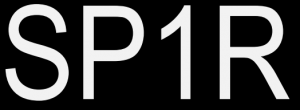 MANUAL
MANUAL
References
[xyz-ips snippet=”download-snippet”]

